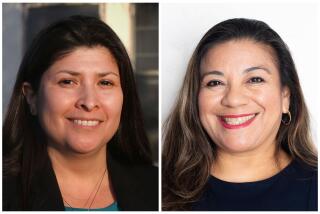Bayard F. Berman dies at 88; attorney won desegregation case against L.A. Unified
- Share via
Bayard F. Berman, a lead attorney on the Los Angeles school desegregation lawsuit that led to three years of busing and an exodus of whites from the city’s public schools, died Jan. 20 at the Veterans Affairs hospital in West Los Angeles. He was 88.
The cause was a gallbladder infection, said his daughter, Abigail.
An entertainment lawyer known for his prowess as a litigator, Berman was approached by the American Civil Liberties Union of Southern California in the late 1960s to handle the biggest lawsuit it had ever taken on. Known as the Crawford case, it was filed as a class action in 1963 by the ACLU and the National Assn. for the Advancement of Colored People to end racial imbalances and improve the quality of education for black and Mexican American students in the Los Angeles Unified School District.
Working pro bono, Berman argued the case before Los Angeles Superior Court Judge Alfred T. Gitelson during a trial that lasted nearly eight months. In 1970, Gitelson ruled that the 600-school system had deliberately perpetuated segregation and ordered the district to integrate every campus according to a percentage formula.
Considered the most important desegregation case since Brown vs. Board of Education in 1954, it was attacked by then-Gov. Ronald Reagan, Los Angeles Mayor Sam Yorty and other officials. After a lengthy appeals process, the case eventually resulted in the district’s mandatory busing plan involving thousands of students and the phenomenon of “white flight” from public education.
In 1979, the electorate voted to end busing by passing Proposition 1. The school board later adopted a voluntary desegregation plan, which led to the creation of a successful system of magnet schools, the chief legacy of the historic lawsuit.
Berman “was certainly important to the school desegregation movement in Los Angeles,” said Ramona Ripston, executive director of the ACLU of Southern California. “Although he was a lawyer in private practice, there wasn’t anybody who cared more about desegregating Los Angeles schools.”
He was born Sept. 15, 1921, in New York City, but, as his daughter noted, he essentially grew up in a car. “His father was a traveling salesman,” Abigail Berman said. “He had been to every state in the continental U.S. by age 13.”
When he was 13, his family moved to Los Angeles. He attended what is now John Burroughs Middle School and the Gulf Coast Military Academy in Mississippi. He earned a bachelor’s degree at UCLA and a business degree at Harvard before serving in the Army Air Forces during World War II. After the war, he earned a law degree at Harvard on the GI Bill before serving in the Judge Advocate General’s Corps during the Korean War.
After completing his military duty, he returned to L.A. and joined Kaplan, Livingston, Goodwin, Berkowitz & Selvin, a prominent entertainment law firm. He became head of its litigation department.
One of the principals of the firm knew Eason Monroe, then the ACLU’s executive director. Monroe asked Berman to take on the Crawford case. Berman was one of the ACLU’s principal attorneys on the controversial litigation, along with the late Fred Okrand and others.
When the trial began, Gitelson told Berman that he would have to challenge a major presumption: that government officials acted properly in their management of the schools. After months of expert testimony and exhibits, Berman ultimately overcame the judge’s skepticism and convinced him that the district was guilty of de facto segregation, which meant that the inequities were the unintended consequence of housing patterns and other factors beyond the district’s control. He also proved de jure, or deliberate, segregation by showing that minorities were required to attend certain schools because of the way the district drew school boundaries and attendance areas.
In an oral history taken by UCLA, Monroe said: “Bayard was able to prove . . . that what looks like de facto is also de jure segregation, and that a whole history of inaction, or of deliberate actions, has been responsible for the continued segregation of Los Angeles schools.”
“He was a formidable litigator,” said attorney Chuck Levy, a former colleague, who recalled that Berman’s stand for minorities’ rights brought death threats and armed guards to the law offices where they worked.
When many white parents began sending their children to private schools to avoid busing, Berman kept his children in public school. “He believed in staying in public schools and making a difference, but a lot of people didn’t agree with that,” Abigail Berman said.
She noted that the failure of the Los Angeles desegregation effort troubled him for many years. “For some time he wondered if that was the right course to take because it changed the city and created a new form of segregation. He later realized he had positively impacted a lot of people’s lives. . . . But he always felt he could have done more.”
In addition to his daughter, Berman is survived by his wife of 48 years, Adrienne; two grandchildren; a niece; and a nephew. A son, Jake, died in 2003, and a grandson, Theo, in 2006.
A memorial service will be held at 1 p.m. Feb. 14 at Leo Baeck Temple, 1300 N. Sepulveda Blvd., Los Angeles.
More to Read
Start your day right
Sign up for Essential California for the L.A. Times biggest news, features and recommendations in your inbox six days a week.
You may occasionally receive promotional content from the Los Angeles Times.







